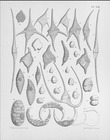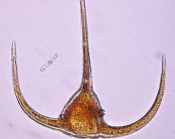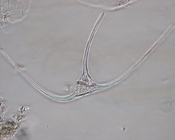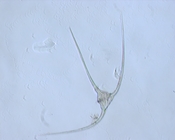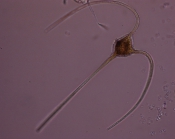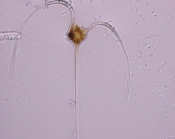WoRMS taxon details
Ceratium F.Schrank, 1793
109506 (urn:lsid:marinespecies.org:taxname:109506)
accepted
Genus
Dimastigoaulax Diesing, 1866 · unaccepted (synonym)
- Species Ceratium axiale Kofoid, 1907
- Species Ceratium brevearcuatum Bohm, 1976
- Species Ceratium candelabum
- Species Ceratium denticulatum (Jörgensen) Paulsen, 1931
- Species Ceratium divaricatum (Lemmermann) Kofoid, 1908
- Species Ceratium hirundinella (O.F.Müller) Dujardin, 1841
- Species Ceratium pacificum E.J.F.Wood, 1963
- Species Ceratium patentissimum Ostenfeld & Johannes Schmidt, 1901
- Species Ceratium pleuroceras Schrank, 1793
- Species Ceratium porrectum Karsten, 1907
- Species Ceratium seta (Ehrenberg) W.S.Kent, 1881
- Species Ceratium tenue Ostenfeld & Schmidt, 1901
- Species Ceratium varians Mangin, 1922
- Species Ceratium aestuarium Schroder, 1911 accepted as Ceratium hexacanthum var. aestuarium (Schroder) J.Schiller, 1937 accepted as Tripos aestuarius (Schröder) F.Gómez, 2013 (synonym)
- Species Ceratium arcuatum (Gourret) Pavillard accepted as Neoceratium euarcuatum (Jörgensen) F.Gómez, D.Moreira & P.Lopez-Garcia, 2010 accepted as Tripos euarcuatus (Jørgensen) F.Gómez, 2013 (synonym)
- Species Ceratium arcuatum (Gourret) Cleve, 1900 accepted as Tripos muelleri var. arcuatus (Gourret) F.Gómez, 2013 (synonym)
- Species Ceratium arietinum Cleve, 1900 accepted as Tripos arietinus (Cleve) F.Gómez, 2021
- Species Ceratium aultii H.W.Graham & Bronikovsky, 1944 accepted as Tripos aultii (H.W.Graham & Bronikovsky) F. Gómez, 2014 (Validity)
- Species Ceratium azoricum Cleve, 1900 accepted as Tripos azoricus (Cleve) F.Gómez, 2013 (synonym)
- Species Ceratium balechii Maeve del Castillo, Okolodkov & Zamudio, 2003 accepted as Tripos dens (Ostenfeld & Johannes Schmidt) F.Gómez, 2013 (unaccepted > junior subjective synonym, Validity)
- Species Ceratium batavum Paulsen, 1908 accepted as Tripos batavus (Paulsen) F.Gómez, 2013 (synonym)
- Species Ceratium belone Cleve, 1900 accepted as Tripos belone (Cleve) F.Gómez, 2013
- Species Ceratium berghii Gourret, 1883 accepted as Tripos fusus (Ehrenberg) F.Gómez, 2013 (unaccepted > junior subjective synonym)
- Species Ceratium biceps Claparède & Lachmann, 1859 accepted as Tripos biceps (Claparède & Lachmann) F.Gómez, 2013 (synonym)
- Species Ceratium biconicum Murray & Whitting, 1899 accepted as Centrodinium biconicum (Murray & Whitting) F.J.R.Taylor, 1976
- Species Ceratium bicorne Gourret, 1883 accepted as Tripos bicornis (Gourret) F.Gómez, 2013
- Species Ceratium bigelowii Kofoid, 1907 accepted as Tripos bigelowii (Kofoid) F.Gómez, 2013
- Species Ceratium boehmii H.W.Graham & Bronikovsky, 1944 accepted as Tripos boehmii (H.W.Graham & Bronikovsky) F.Gómez, 2013 (synonym)
- Species Ceratium breve (Ostenfeld & Schmidt) Schröder, 1906 accepted as Tripos brevis (Ostenfeld & Johannes Schmidt) F.Gómez, 2013
- Species Ceratium brunellii Rampi, 1942 accepted as Tripos brunellii (Rampi) F.Gómez, 2013
- Species Ceratium bucephalum (Cleve) Cleve, 1900 accepted as Tripos bucephalus (Cleve) F.Gómez, 2013 (synonym)
- Species Ceratium buceros Zacharias, 1906 accepted as Tripos buceros (Zacharias) F.Gómez, 2013 (synonym)
- Species Ceratium californiense Kofoid, 1907 accepted as Tripos californiensis (Kofoid) F.Gómez, 2013 (synonym)
- Species Ceratium candelabrum (Ehrenberg) F.Stein, 1883 accepted as Tripos candelabrum (Ehrenberg) F.Gómez, 2013
- Species Ceratium carnegiei H.W.Graham & Bronikovsky, 1944 accepted as Tripos carnegiei (H.W.Graham & Bronikovsky) F.Gómez, 2013
- Species Ceratium carriense Gourret, 1883 accepted as Tripos carriensis (Gourret) F.Gómez, 2013 (synonym)
- Species Ceratium cephalotum (Lemmermann) Jörgensen, 1911 accepted as Tripos cephalotus (Lemmermann) F.Gómez, 2013
- Species Ceratium ceylanicum Schröder, 1906 accepted as Tripos ceylanicus (Schröder) F.Gómez, 2013
- Species Ceratium claviger Kofoid, 1907 accepted as Tripos claviger (Kofoid) F.Gómez, 2013 (synonym)
- Species Ceratium coarctatum Pavillard, 1905 accepted as Tripos coarctatus (Pavillard) F.Gómez, 2013 (synonym)
- Species Ceratium compressum Gran, 1912 accepted as Tripos compressus (Gran) F.Gómez, 2013
- Species Ceratium concilians Jörgensen, 1920 accepted as Tripos concilians (Jørgensen) F.Gómez, 2013
- Species Ceratium contortum (Gourret) Cleve, 1900 accepted as Tripos contortus (Gourret) F.Gómez, 2013
- Species Ceratium contrarium (Gourret) Pavillard, 1905 accepted as Tripos contrarius (Gourret) F.Gómez, 2013
- Species Ceratium curvicorne (Daday) Cleve, 1900 accepted as Tripos curvicornis (Daday) F.Gómez, 2013
- Species Ceratium declinatum (Karsten) Jørgensen, 1911 accepted as Tripos declinatus (G.Karsten) F.Gómez, 2013
- Species Ceratium declinatum G.Karsten, 1907 accepted as Tripos declinatus (G.Karsten) F.Gómez, 2013 (synonym)
- Species Ceratium deflexum (Kofoid) Jörgensen, 1911 accepted as Tripos deflexus (Kofoid) F.Gómez, 2013
- Species Ceratium dens Ostenfeld & J.Schmidt, 1901 accepted as Tripos dens (Ostenfeld & Johannes Schmidt) F.Gómez, 2013 (unaccepted > superseded combination)
- Species Ceratium depressum Gourret, 1883 accepted as Tripos candelabrum (Ehrenberg) F.Gómez, 2013
- Species Ceratium digitatum F.Schütt, 1895 accepted as Tripos digitatus (F.Schütt) F.Gómez, 2013
- Species Ceratium dilatatum Gourret, 1883 accepted as Tripos candelabrum (Ehrenberg) F.Gómez, 2013
- Species Ceratium divergens (Ehrenberg) Claparède & Lachmann, 1859 accepted as Protoperidinium divergens (Ehrenberg) Balech, 1974
- Species Ceratium egyptiacum Halim, 1963 accepted as Tripos egyptiacus (Halim) F.Gómez, 2013 (Validity)
- Species Ceratium ehrenbergii Kofoid, 1907 accepted as Tripos ehrenbergii (Kofoid) F.Gómez, 2013 (Validity)
- Species Ceratium elegans Schröder, 1906 accepted as Tripos elegans (Schröder) F.Gómez, 2013
- Species Ceratium euarcuatum Jørgensen, 1920 accepted as Tripos euarcuatus (Jørgensen) F.Gómez, 2013
- Species Ceratium eugrammum Kofoid accepted as Neoceratium minutum (Jörgensen) F.Gómez, D.Moreira & P.López-Garcia, 2010 accepted as Tripos minutus (E.G.Jørgensen) F.Gómez, 2013 (synonym)
- Species Ceratium eugrammum (Ehrenberg) W.S.Kent, 1881 accepted as Tripos eugrammus (Ehrenberg) F.Gómez, 2013 (synonym)
- Species Ceratium extensum (Gourret) Cleve-Euler, 1900 accepted as Tripos extensus (Gourret) F.Gómez, 2013
- Species Ceratium falcatiforme Jörgensen, 1920 accepted as Tripos falcatiformis (Jørgensen) F.Gómez, 2013
- Species Ceratium falcatum (Kofoid) Jörgensen, 1920 accepted as Tripos falcatus (Kofoid) F.Gómez, 2013
- Species Ceratium filicorne Steemann Nielsen, 1934 accepted as Tripos filicornis (Steemann Nielsen) F.Gómez, 2013
- Species Ceratium flagelliferum Cleve, 1900 accepted as Tripos flagelliferus (Cleve) F.Gómez, 2013 (synonym)
- Species Ceratium furca (Ehrenberg) Claparède & Lachmann, 1859 accepted as Tripos furca (Ehrenberg) F.Gómez, 2013
- Species Ceratium fusus (Ehrenberg) Dujardin, 1841 accepted as Tripos fusus (Ehrenberg) F.Gómez, 2013
- Species Ceratium gallicum Kofoid, 1907 accepted as Tripos gallicus (Kofoid) F.Gómez, 2013 (synonym)
- Species Ceratium geniculatum (Lemmermann) Cleve, 1901 accepted as Tripos geniculatus (Lemmermann) F.Gómez, 2013
- Species Ceratium gibberum Gourret, 1883 accepted as Tripos gibberus (Gourret) F.Gómez, 1883
- Species Ceratium globatum Gourret, 1883 accepted as Tripos candelabrum (Ehrenberg) F.Gómez, 2013 (synonym)
- Species Ceratium globosum Gourret, 1883 accepted as Tripos globosus (Gourret) F.Gómez, 2013
- Species Ceratium gracile (Gourret) Jorgensen, 1911 accepted as Neoceratium symmetricum (Pavillard) F.Gómez, D.Moreira & P.Lopez-Garcia, 2010 accepted as Tripos symmetricus (Pavillard) F.Gómez, 2013 (synonym)
- Species Ceratium gracile Pavillard, 1905 accepted as Tripos gracilis (Pavillard) F.Gómez, 2013
- Species Ceratium gravidum Gourret, 1883 accepted as Tripos gravidus (Gourret) F.Gómez, 2013
- Species Ceratium heterocamptum (Jörgensen) Ostenfeld & Schmidt, 1901 accepted as Tripos heterocamptus (Jörgenen) F.Gómez, 2013
- Species Ceratium hexacanthum Gourret, 1883 accepted as Tripos hexacanthus (Gourret) F.Gómez, 2013
- Species Ceratium hircus Schröder, 1909 accepted as Tripos hircus (Schröder) F.Gómez, 2013
- Species Ceratium horridum (Cleve) Gran, 1902 accepted as Tripos horridus (Cleve) F.Gómez, 2013
- Species Ceratium humile Jörgensen, 1911 accepted as Tripos humilis (Jörgenen) F.Gómez, 2013 (synonym)
- Species Ceratium hundhausenii Schröder, 1906 accepted as Tripos hundhausenii (Schröder) F.Gómez, 2013 (synonym)
- Species Ceratium hyperboreum Cleve, 1900 accepted as Tripos hyperboreus (Cleve) F.Gómez, 2013
- Species Ceratium incisum (G.Karsten) Jørgensen, 1911 accepted as Tripos incisus (Karsten) F.Gómez, 2013
- Species Ceratium inclinatum Kofoid, 1907 accepted as Tripos inclinatus (Kofoid) F.Gómez, 2013 (synonym)
- Species Ceratium inflatum (Kofoid) E.G.Jørgensen, 1911 accepted as Tripos inflatus (Kofoid) F.Gómez, 2013
- Species Ceratium intermedium (Jorgensen) Jorgensen, 1905 accepted as Tripos intermedius (Jörgenen) F.Gómez, 2013 (synonym)
- Species Ceratium inversum Karsten, 1907 accepted as Tripos inversus (Karsten) F.Gómez, 2013
- Species Ceratium japonicum Schröder, 1906 accepted as Tripos japonicus (Schröder) F.Gómez, 2013 (synonym)
- Species Ceratium karstenii Pavillard, 1907 accepted as Tripos karstenii (Pavillard) F.Gómez, 1907
- Species Ceratium kofoidii Jørgensen, 1911 accepted as Tripos kofoidii (E.G.Jørgensen) F.Gómez, 2013
- Species Ceratium labradoricum Vanhoffen, 1897 accepted as Neoceratium arcticum (Ehrenberg) F.Gómez, D.Moreira & P.López-Garcia, 2010 accepted as Ceratium arcticum (Ehrenberg) L.Maggi, 1880 accepted as Tripos arcticus (Vanhöffen) F.Gómez, 2013 (synonym)
- Species Ceratium lamellicorne Kofoid, 1908 accepted as Tripos lamellicornis (Kofoid) F.Gómez, 2013 (synonym)
- Species Ceratium lanceolatum Kofoid, 1907 accepted as Tripos lanceolatus (Kofoid) F.Gómez, 2013 (Validity)
- Species Ceratium leptosomum Jörgensen, 1911 accepted as Tripos leptosomus (E.G.Jørgensen) F.Gómez, 2013 (synonym)
- Species Ceratium limulus (Pouchet) Gourret, 1883 accepted as Tripos limulus (Pouchet) F.Gómez, 2013
- Species Ceratium lineatum (Ehrenberg) Cleve, 1899 accepted as Tripos lineatus (Ehrenberg) F.Gómez, 2013
- Species Ceratium longicorne Perty, 1849 accepted as Ceratium hirundinella (O.F.Müller) Dujardin, 1841 (synonym)
- Species Ceratium longinum (Karsten) Jörgensen, 1911 accepted as Tripos longinus (Karsten) F.Gómez, 2013 (synonym)
- Species Ceratium longipes (Bailey) Gran, 1902 accepted as Tripos longipes (Bailey) F.Gómez, 2013
- Species Ceratium longirostrum Gourret, 1883 accepted as Tripos longirostrum (Gourret) Hallegraeff & Huisman, 2020
- Species Ceratium longissimum (Schröder) Kofoid, 1907 accepted as Tripos longissimus (Schröder) F.Gómez, 2013 (synonym)
- Species Ceratium lunula Schimper ex Karsten, 1906 accepted as Tripos lunula (Schimper ex Karsten) F.Gómez, 2013
- Species Ceratium macroceras Schrank, 1802 accepted as Ceratium hirundinella (O.F.Müller) Dujardin, 1841 (synonym)
- Species Ceratium macroceros (Ehrenberg) Vanhöffen, 1897 accepted as Tripos macroceros (Ehrenberg) Hallegraeff & Huisman, 2020
- Species Ceratium macroceros (Ehrenberg) Cleve, 1899 accepted as Tripos macroceros (Ehrenberg) Hallegraeff & Huisman, 2020 (synonym)
- Species Ceratium massiliense (Gourret) Karsten, 1906 accepted as Tripos massiliensis (Gourret) F.Gómez, 2013
- Species Ceratium michaelis (Ehrenberg) W.S.Kent, 1881 accepted as Protoperidinium steinii (Jørgensen, 1899) Balech, 1974 (synonym)
- Species Ceratium minus Gourret, 1883 accepted as Tripos minor (Gourret) Gómez, 2013
- Species Ceratium minutum Jörgensen, 1920 accepted as Tripos minutus (E.G.Jørgensen) F.Gómez, 2013
- Species Ceratium molle Kofoid, 1907 accepted as Tripos mollis (Kofoid) F.Gómez, 2013
- Species Ceratium mollis Kofoid, 1907 accepted as Ceratium molle Kofoid, 1907 accepted as Tripos mollis (Kofoid) F.Gómez, 2013 (synonym)
- Species Ceratium neglectum Ostenfeld, 1903 accepted as Tripos neglectus (Ostenfeld) F.Gómez, 2013 (synonym)
- Species Ceratium obesum Pavillard, 1930 accepted as Tripos obesus (Pavillard) F.Gómez, 2013 (synonym)
- Species Ceratium obliquum Gourret, 1883 (unaccepted)
- Species Ceratium obtusum Gourret, 1883 (unaccepted)
- Species Ceratium okamurae Schröder, 1906 (unaccepted)
- Species Ceratium ostenfeldii Kofoid, 1907 (unaccepted)
- Species Ceratium oviforme Daday, 1888 (unaccepted, synonym)
- Species Ceratium pacificum Schröder, 1906 (unaccepted)
- Species Ceratium palmatum (Schroder) Schroder (unaccepted, synonym)
- Species Ceratium paradoxides Cleve, 1900 (unaccepted)
- Species Ceratium parvum Gourret, 1883 (unaccepted)
- Species Ceratium pavillardii Jørgensen, 1911 (unaccepted)
- Species Ceratium pellucidum Gourret, 1883 (unaccepted)
- Species Ceratium pennatum Kofoid, 1907 (unaccepted)
- Species Ceratium pentagonum Gourret, 1883 (unaccepted)
- Species Ceratium petersii Steemann Nielsen, 1934 (unaccepted)
- Species Ceratium platycorne Daday, 1888 (unaccepted, basionym)
- Species Ceratium praelongum (Lemmermann) Kofoid ex Jörgensen, 1911 (unaccepted)
- Species Ceratium procerum Gourret, 1883 (unaccepted)
- Species Ceratium protuberans (Karsten) Paulsen, 1931 (unaccepted)
- Species Ceratium pulchellum Schröder, 1906 (unaccepted)
- Species Ceratium ramakrishnae Subrahmanyan, 1968 (unaccepted, synonym)
- Species Ceratium ranipes Cleve, 1900 (unaccepted)
- Species Ceratium recurvatum Schröder, 1906 (unaccepted, synonym)
- Species Ceratium recurvum (Jørgensen) Reinecke, 1973 (unaccepted, synonym)
- Species Ceratium reflexum Cleve, 1900 (unaccepted)
- Species Ceratium reticulatum (Pouchet) Cleve, 1900 (unaccepted, synonym)
- Species Ceratium robustum Ostenfeld & Johannes Schmidt, 1901 (unaccepted, synonym)
- Species Ceratium rostellum Gourret, 1883 (unaccepted)
- Species Ceratium saltans Schröder, 1906 (unaccepted, synonym)
- Species Ceratium scapiforme Kofoid, 1907 (unaccepted, synonym)
- Species Ceratium schmidtii Jørgensen, 1911 (unaccepted, synonym)
- Species Ceratium schrankii Kofoid, 1907 (unaccepted, synonym)
- Species Ceratium schroederi Nie, 1936 (unaccepted, synonym)
- Species Ceratium schroeteri B.Schröder, 1906 (unaccepted)
- Species Ceratium setaceum Jørgensen, 1911 (unaccepted)
- Species Ceratium strictum (Okamura & Nishikawa) Kofoid, 1906 (unaccepted, synonym)
- Species Ceratium subcontortum Schröder, 1906 (unaccepted)
- Species Ceratium subrobustum (Jorgensen) Steemann Nielsen, 1934 (unaccepted, synonym)
- Species Ceratium subsalsum (Ostenfeld) Apstein, 1911 (unaccepted)
- Species Ceratium sumatranum (Karsten) Jørgensen, 1911 (unaccepted, synonym)
- Species Ceratium symmetricum Pavillard, 1905 (unaccepted)
- Species Ceratium tasmaniae E.J.F.Wood, 1963 (unaccepted, Validity)
- Species Ceratium tenuissimum Kofoid, 1907 (unaccepted, synonym)
- Species Ceratium teres Kofoid, 1907 (unaccepted)
- Species Ceratium tricarinatum Kofoid, 1907 (unaccepted, synonym)
- Species Ceratium trichoceros (Ehrenberg) Kofoid, 1881 (unaccepted)
- Species Ceratium tripodioides (Jorgensen) Steemann Nielsen, 1934 (unaccepted, synonym)
- Species Ceratium tripos (O.F.Müller) Nitzsch, 1817 (unaccepted)
- Species Ceratium uncinus Sournia, 1972 (unaccepted, Validity)
- Species Ceratium uteri A.S.Campbell, 1934 (unaccepted, Validity)
- Species Ceratium volans Cleve, 1900 (unaccepted, synonym)
- Species Ceratium vultur Cleve, 1900 (unaccepted, synonym)
- Species Ceratium inflatum N.Peters, 1934 (uncertain, uncertain taxonomic status subjected to verification)
- Species Ceratium inflexum (Gourret) Schröder (uncertain, uncertain taxonomic status subjected to verification)
- Species Ceratium quinqueforme Gourret, 1883 (uncertain > unassessed)
marine, fresh
neuter
Not documented
LSID urn:lsid:algaebase.org:taxname:6795
Taxonomy The delimitation of species or infraespecific taxa strongly varies among authors
LSID urn:lsid:algaebase.org:taxname:6795 [details]
Taxonomy The delimitation of species or infraespecific taxa strongly varies among authors
Taxonomy The delimitation of species or infraespecific taxa strongly varies among authors [details]
Guiry, M.D. & Guiry, G.M. (2025). AlgaeBase. World-wide electronic publication, National University of Ireland, Galway (taxonomic information republished from AlgaeBase with permission of M.D. Guiry). Ceratium F.Schrank, 1793. Accessed through: World Register of Marine Species at: https://www.marinespecies.org/aphia.php?p=taxdetails&id=109506 on 2025-07-14
Date
action
by
2004-12-21 15:54:05Z
created
db_admin
![]() The webpage text is licensed under a Creative Commons
Attribution 4.0 License
The webpage text is licensed under a Creative Commons
Attribution 4.0 License
Nomenclature
basis of record
Gómez, F. (2005). A list of free-living dinoflagellate species in the world's oceans. <em>Acta Bot. Croat.</em> 64(1): 129-212. [details] 
Other
additional source
Guiry, M.D. & Guiry, G.M. (2025). AlgaeBase. <em>World-wide electronic publication, National University of Ireland, Galway.</em> searched on YYYY-MM-DD., available online at http://www.algaebase.org
page(s): 34 [details]
additional source Parker, S.P. (Ed.) (1982). Synopsis and classification of living organisms. McGraw Hill Book Company: New York, NY (USA). ISBN 0-07-079031-0. 1166, 1232 pp. (look up in IMIS) [details]
page(s): 34 [details]
additional source Parker, S.P. (Ed.) (1982). Synopsis and classification of living organisms. McGraw Hill Book Company: New York, NY (USA). ISBN 0-07-079031-0. 1166, 1232 pp. (look up in IMIS) [details]
 Present
Present  Inaccurate
Inaccurate  Introduced: alien
Introduced: alien  Containing type locality
Containing type locality
From editor or global species database
LSID urn:lsid:algaebase.org:taxname:6795 [details]Unreviewed
Ecology C. fusus, C. furca and C. lineatum are the Ceratium species that have formed blooms in the North Sea or adjacent waters. A relatively small concentration of 5 105 cells/l can have a major impact because of the size of the cells (up to 250 µm). A relationship between the size of the Ceratium stock and salinity was determined. As salinity decreased, Ceratium numbers increased. [details]Taxonomy The delimitation of species or infraespecific taxa strongly varies among authors [details]
| Language | Name | |
|---|---|---|
| Japanese | ケラチウム属 | [details] |



